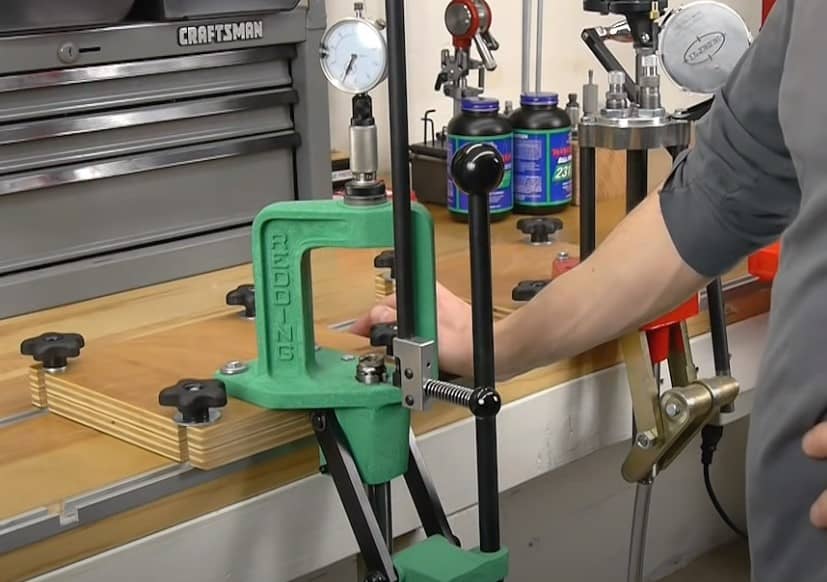Types Of Presses For Reloading – Everything You Need To Know

There are many ways to go about reloading; it could be as easy as pushing a button or as painful as pulling a trigger. Some people enjoy it because it saves them some money on ammunition.
But, on the other hand, the project might end up costing you more if you don’t know what you’re doing or don’t have the right equipment. However, before you start, you must buy a reloading press.
Since there are several types of reloading presses available, choosing the right one can be quite challenging. That will be fixed here, don’t worry. Every reloading press has its own purpose. There are many types and sizes of reloading presses.
Reloading Presses: What Types Are There?
As a hobby, I have found reloading ammunition to be fun and rewarding. However, a reloading press is something you will need to buy the first time you start reloading.
What type of press you need depends on how many rounds of ammunition you need to produce and the purpose of the press. I will describe the types of reloading presses, their best uses, and how much experience a reloader needs to operate them below.
1. Shotshell Press
Reloading ammunition for rifles and handguns is the most common use for reloading ammo. The majority of shotgun shells are loaded by hand, however. As a result, shooters can create specialized bullets for use in a wide range of situations.
To reload shotgun shells, a different reloading press must be used compared to handgun and rifle cartridges. Shotshell presses are available in single-stage and progressive versions, just as they are for rifle and handgun cartridges.
When purchasing a shotshell press, choose one that matches your caliber and shell length. Most presses come with a specific length and caliber, although many can be changed.
2. Progressive Reloading Press
During each cycle of the lever, progressive reloading presses create one completed round. In order to accomplish this, a shell plate is used that can simultaneously hold multiple cases.
Several processes are happening simultaneously in the process of raising the ram by pressing down on the lever. As soon as the ram is cycled, the shell plate turns (indexes). The last round is kicked into the completed round bin or chute after each shell is ready for its next operation.
In some progressive presses, the indexing takes place automatically when the pressing is done, while in others, it must be done manually (manual indexing progressive presses).
Those loading .223 ammunition and pistols often use progressive reloading presses. Due to the lower quantities involved, progressive reloading presses can also be used for bolt action rifle loading.
However, turret-type presses or single-stage presses are most commonly used for this type of loading. A case feeder attachment may be available on some progressive reloading presses.
When the lever is pushed, a case is automatically inserted into the shell plate. By doing this, you will be able to speed up the reloading process considerably.
Case feeders are available in various types, from manual tube feeders to motorized feeders that automatically refill tubes. They are best suited for bulk reloading operations because they increase press complexity and require additional setup time for caliber changes.
3. Turret Press
In the turret press, multiple dies are held simultaneously so you can manually quickly index from one die to another. The press works similarly to the single-stage press (one die acts on a cartridge at a time) but holds multiple dies simultaneously.
The indexing of some turret presses can also be automated, so no manual indexing is needed. When turret presses are equipped with indexing features, the process can be sped up even further by reducing the number of lever strokes required per round.
Reloading with turret presses can be less precise than with a single stage press due to more flex, but this is rarely an issue. Regarding rifle or pistol reloading, a turret press can be a great starter or a great precision press for the more experienced reloader.
4. Single Stage
A single stage reloading press is the simplest type of press. One die is held at a time in this press. It usually has a rigid frame and is most commonly used for reloading rifle cartridges.
During the pressing process, the die is screwed into an opening on top of the press, while the shell holder is attached to the ram, where the cartridge case rim is held in place.
The ram rises by pressing down the lever, and the die is pushed against the case. Most single-stage presses have priming attachments, but hand priming is usually done separately. It takes the longest for single-stage presses to complete a round per hour and for die switching and setup, etc.
5. Hand Press
Reloading presses can also be operated by hand. It is portable and does not require mounting onto a workbench, as other reloading presses do. This type of device is hand-held, as the name suggests.
In addition to being portable, a hand press offers several advantages. Due to the fact that it does not require mounting to a bench, it can be taken almost anywhere and is easy to use. Whether you are on the range, at camp, or in an apartment, a hand press allows you to reload small quantities.
Someone without a lot of space or who doesn’t need to load a lot of ammo at once might find a hand press a better choice. Reloading sessions could be extremely tiring because of their design, especially with larger calibers.
It is very affordable to buy a hand press. There are several recent models available for under $40.00. An example of a popular type of hand press is the Lee Hand Press. Gun owners have well received this press.
The Bottom Line
Whatever type of reloading you want to do that’s entirely up to you. The single stage reloader is suitable for bench rest shooters and precision shooters who enjoy monitoring each step.
A progressive reloading press is a useful tool for plinkers who have a lot of money to invest and do a lot of plinking. Both features are combined in the turret press. The speed is not as fast as a progressive, but you get more precision.

